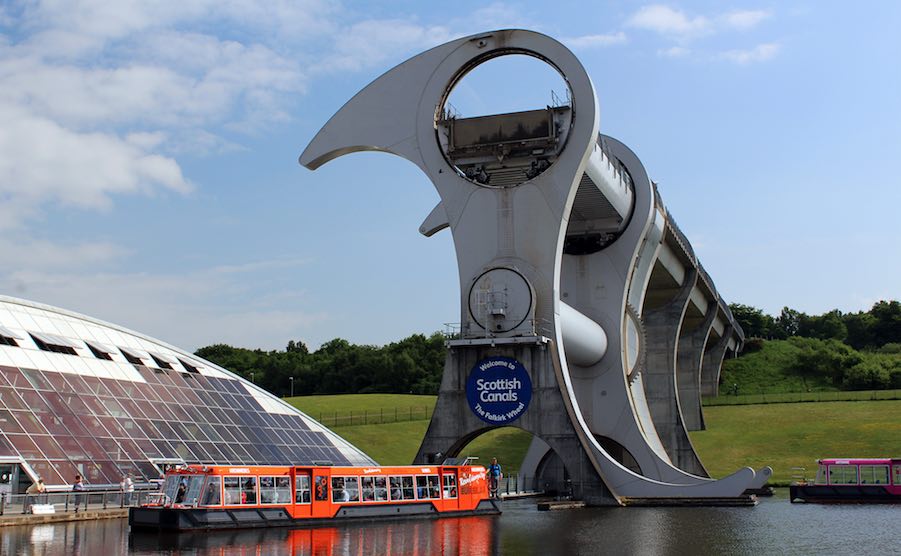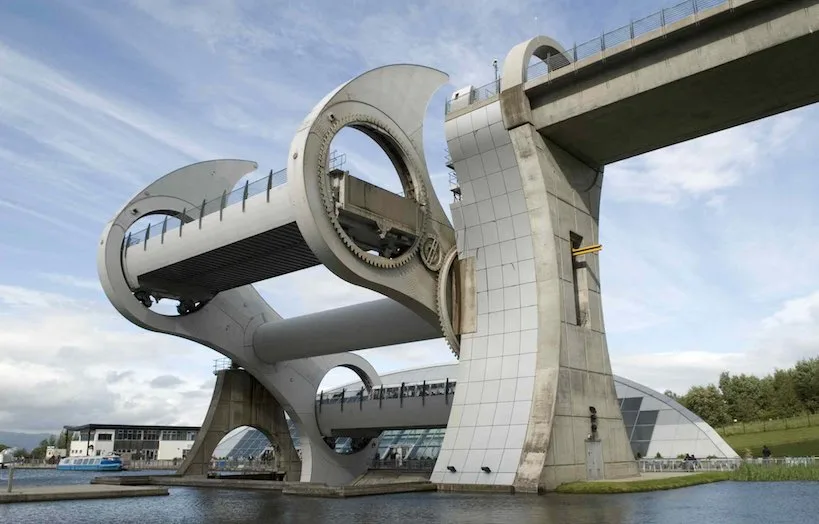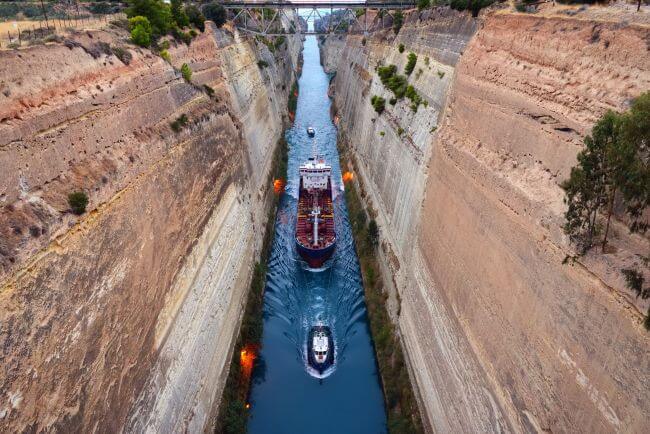28 November 2024
What is the Falkirk wheel? Advanced boat lift

What is the Falkirk Wheel? It is the world’s first rotating boat lift designed to connect the Union Canal with the Forth and Clyde Canal 25 meters below and forms part of the Millennium Link Project.
Table of Contents
Concept
Over the course of time, man-made canals were built to facilitate the movement of goods and people. By opening new corridors or for irrigation purposes. Usually, canals are constructed with a series of locks and dams.
The first modern canals emerged at the height of the Industrial Revolution. Since then, innovative ideas and state-of-the-art techniques have been deployed to create some engineering marvels of today’s world. In Scotland, the Falkirk wheel was built to bridge the fourth and Clyde canal with the Union canal and reconnect Glasgow with Edinburgh.
The two cities were previously linked by a flight of 11 locks. These were dismantled in 1933. Inaugurated in 2002, the Falkirk wheel is the world’s first and only rotating boat lift.
Design & Construction
The massive structure was designed using 1,200 tons of steel and over 1,000 construction staff. The shape of this genuine wheel was inspired by a Celtic double-headed spear.
It has a diameter of 115 feet and two opposing arms extending 49 feet beyond the central axle. The end of each arm is equipped with a water-filled casein or Gondola that can lift 55,000 gallons. Each of the two casings is 21 feet wide and can hold up to four 66-foot-long narrow boats.
Even though the wheel lifts boasts 79 feet, the union Canal is still 36 feet higher. Therefore, boats must pass through a pair of locks between the aqueduct on the top of the wheel and the union canal. To travel from the 4th and Clyde Canal to the union Canal a boat first moves into one of the two casins.

Operating Principle
According to Archimedes’s principle, floating objects displace their own weight in water. So, even if one casein is empty and the other is loaded with boats their respective weights are precisely the same, roughly 500 tons. This means that the proper operation of the wheel depends on maintaining an equal water level in each casein. This is constantly monitored by Electric sensors.
Note that, 2 hydraulic watertight steel gates are raised to seal off the casein. The water between the gates is then pumped out along with a watertight seal that connects the casein with the basin. The hydraulic clamp and the securing pins that fix the wheel arms while the casings are loaded are removed and the Falkirk wheel starts to turn. Particularly, 10 hydraulic motors begin to rotate a central axle connected to the outer arms at a speed of 18 revs/min.
It takes 4 minutes to complete the half-turn and Elevate the boat 79 feet to the aqueduct. The boat is now ready to pass through the locks. This is meticulously monitored by a house operator that ensures all safety measures are checked before starting the process. The wheel can turn clockwise or counterclockwise but to prevent too much wear and tear, the operator in the control room balances out how often it goes in each direction.
Gearing System
As the wheel rotates, a gearing system of three large identically sized gears connected by two smaller ones ensures the two casings remain upright. When the central axle rotates, the arms swing causing the smaller gears to rotate in the same direction but at a higher speed than the wheel.
The large ring gears are then engaged by the small gears driving them up at the same speed as the wheel but in the opposite direction. This prevents the arms from rotating and keeps the casings stable and perfectly level.
Despite its immense size, the Falkirk wheel is remarkably energy efficient. Actually, it uses only 1.5 kWh of energy to rotate. Roughly the same amount as it would take to boil 8 electric kettles.
Corinth Canal
In Greece, the Corinth Canal was created to connect the Gulf of Corinth in the Ionian sea with the Saronic gulf and the Aegean Sea. Hence, converting the Peloponnese peninsula into an island. The Corinth Canal was opened to shipping for the first time in 1893, fulfilling a project that had been in construction for at least 2,500 years. One of the greatest engineering achievements the world has ever witnessed.
The artificial Waterway was dug 26 feet deep in the Isthmus of Corinth at sea level and had no locks. It consists of a single channel of 4 miles long but only 80.7 feet wide, making it the narrowest canal in the world.
Moreover, the Corinth Canal is framed by two near vertical 80-degree angle rock walls that stand at a height of almost 300 feet above sea level. At the top of these walls railway, motorway, and road bridges cross the canal to enable the transit of non-mariner traffic.

In addition, 2 submersible bridges are installed at each end of the canal to allow road traffic to cross between passing ships. Transiting the Corinth Canal is as simple as keeping the boat centered at a long Channel. However, large vessels including those exceeding 800 net tonnage or carrying potentially dangerous cargo must be assisted by local pilots and towed by tugboats.
Ships can pass through the canal only one Convoy at a time on a one-way system. Despite saving almost 730 miles to Journey around the Peloponnese, the canal is too tight for modern large vessels as it can accommodate ships only of a width up to 58 feet and a draft up to 24 feet.
Nevertheless, many small commercial vessels and cruise ships still make a voyage through the canal.
Panama Canal
In the other corner of the world, the Panama Canal was constructed as a dramatic 20th century project that supported the free movement of billions of goods and trade. This was considered, unlike the Falkirk wheel and the Corinth canal which are of little economic importance as they are mainly used for tourism.
Built on the Isthmus of Panama, the Panama Canal bridged the Pacific and the Atlantic Oceans. Thus, eliminating a journey of 8,000 miles and often precarious routes around Cape Horn. It is one of the Supreme human achievements of all time.

How do ships transit through Panama Canal?
How do ships transit through Panama Canal? Get to know how ships pass from the Atlantic to the Pacific Ocean and vice versa.
Ship Nerd
Canal locks lift ships up to Gatton Lake, then lower them back to sea level on the opposite side. The original locks are 110 feet wide and can accommodate only Panamax-size vessels. Consequently, a third set of wider locks was constructed and began operation in June 2016. The expanded Panama Canal allows not only the transit of larger Neopanamax ships, but also side-by-side passage.
Ships move through these locks, aided by their engines including the assistance of powerful locomotives, also known as mules. Larger ships are also assisted by tugboats to arrive and enter the locks. Vessels transiting the Panama Canal pass through several locks to hit a height of 81 feet above sea level. After reaching Gatton Lake, ships start to descend over three locks.

The ship moves to the first chamber and the gate closes behind. 18-foot wide water culverts are then opened to drain water and lower the vessel to the next lock. As the water levels equalize the vessel, moves forward to the next step until it is entirely lowered into the Pacific Ocean. The whole process is carefully monitored by the control room.
Today, the Panama Canal serves more than 144 Maritime routes and 13 000 vessels annually. Also, it is classified as one of the seven wonders of the modern world.
Conclusion
As the challenges for new maritime routes arise, canals with incredible structures and technologies are constructed to shortcut distances and make comfortable journeys possible.
See Also

How cruise ships evolved in the past century?
Cruise ships are a great innovation in sea-going vehicles which have vastly evolved in the past century. See how much.


